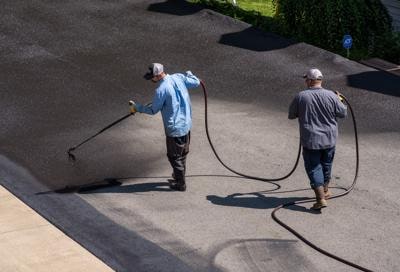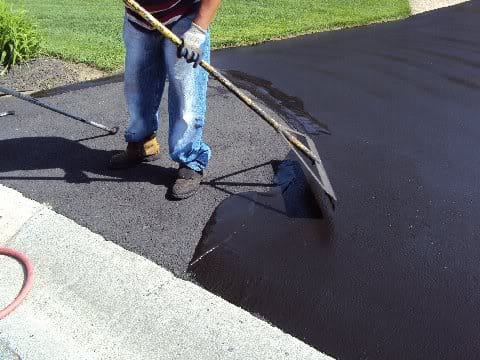Rejuvenate Your Property with Regrading and Asphalt Sealing Techniques
Rejuvenate Your Property with Regrading and Asphalt Sealing Techniques
Blog Article
Warm Mix Asphalt: A Lasting Remedy for Sidewalk
Warm Mix Asphalt (HMA) has emerged as a leading lasting selection for pavement services, providing a myriad of environmental benefits and ingenious technologies. As the need for environment-friendly building techniques expands, discovering the nuances of HMA's sustainability can give important understandings into the future of pavement options.
Environmental Advantages of Hot Mix Asphalt

Additionally, Warm Mix Asphalt aids to minimize city warmth island effects. Its dark shade takes in sunlight, minimizing the amount of warmth mirrored back into the atmosphere contrasted to lighter-colored sidewalks. This can reduce ambient temperature levels in city locations, reducing the need for air conditioning and eventually decreasing power usage.
On top of that, Hot Mix Asphalt adds to boosted stormwater administration. Its porous nature enables water to reenergize and penetrate the sidewalk groundwater materials, decreasing runoff and the threat of flooding. These environmental advantages make Warm Mix Asphalt a lasting option for paving roads and freeways.
Energy Effectiveness in HMA Production
Is energy efficiency a critical element in the production of Warm Mix Asphalt (HMA)? Energy plays a considerable duty in the production of HMA, influencing both expense and environmental sustainability. One crucial aspect of energy effectiveness in HMA production is the use of warm mix asphalt (WMA) innovations.
Furthermore, advancements in plant technologies have brought about more energy-efficient HMA production procedures. Modern plants are developed with features like recycled asphalt sidewalk (RAP) handling capacities, effective burner systems, and improved insulation, all contributing to power financial savings. By optimizing power use in HMA production, the market can lower its carbon footprint while preserving high-grade sidewalk materials. Power performance is, therefore, an essential factor to consider in guaranteeing the sustainability of Hot Mix Asphalt manufacturing.
Recyclability of Hot Mix Asphalt
The recyclability of Warm Mix Asphalt (HMA) is a crucial facet of its sustainability and long-lasting environmental influence. HMA is among one of the most recycled products in the United States, with over 100 million heaps of redeemed asphalt sidewalk (RAP) being recycled annually in new pavement building. Reusing HMA supplies a number of ecological advantages, such as decreasing the demand for virgin products, lowering energy consumption throughout manufacturing, and lowering the quantity of waste sent to garbage dumps.
The procedure of reusing HMA entails crushing the existing sidewalk, squashing it right into smaller sized pieces, and mixing it with brand-new accumulation and asphalt binder to produce a recycled mix. This recycled mix can commonly do along with and even better than conventional HMA, while requiring less basic materials and generating lower greenhouse gas emissions. By incorporating RAP right into new pavement tasks, roadway firms can conserve natural resources, decrease prices, and reduce the ecological footprint of roadway construction and upkeep tasks. Overall, the recyclability of HMA plays a significant function in promoting sustainable practices within the sidewalk market.

Long-Term Performance of HMA
Asphalt sidewalks show resilience and strength over a prolonged duration, reflecting the lasting efficiency of Hot Mix Asphalt (HMA) In addition, developments in HMA modern technology, such as the use of polymer-modified binders and cozy mix asphalt, have actually even more boosted the resilience and longevity of HMA pavements. By prioritizing quality building and maintenance practices, HMA proceeds to prove itself as a affordable and sustainable solution for long-lasting pavement facilities.

HMA: Toughness and Sustainability
Demonstrating both durability and sustainability, Hot Mix Asphalt (HMA) has actually come to be a foundation in the building and construction of durable pavement facilities - hot mix asphalt. HMA's content longevity stems from its capacity to withstand heavy tons, severe climate condition, and high web traffic volumes, making it a reliable choice for highways, highways, and airport terminal paths. The structure of HMA, which typically consists of accumulations, binder, look at these guys and filler, plays an essential role in enhancing its longevity and resistance to deterioration
Moreover, HMA's sustainability lies in its recyclability and energy-efficient production procedure. The ability to reuse redeemed asphalt pavement (RAP) in new HMA blends minimizes the need for virgin products and lessens the ecological influence of pavement building and construction and upkeep. In addition, the power performance of producing HMA hinges on its reduced blending temperatures contrasted to other pavement materials, causing lowered power intake and greenhouse gas exhausts.
Conclusion
To conclude, warm mix asphalt (HMA) offers a sustainable solution for pavement with its eco-friendly qualities. HMA's recyclability, energy efficiency in manufacturing, and lasting durability make it an environmentally friendly selection for road building and construction. By conserving natural deposits, minimizing waste, and decreasing greenhouse gas emissions, HMA plays an important duty in advertising sustainability in infrastructure development. Its capacity to alleviate metropolitan heat island results further highlights its significance in developing eco conscious and durable pavement systems.
HMA is one of the most recycled materials in the United States, with over 100 million lots of redeemed asphalt sidewalk (RAP) being recycled every year in new sidewalk building.The procedure of reusing HMA involves milling the existing sidewalk, crushing it into smaller pieces, and mixing it with new aggregate and asphalt binder to create a recycled mix.Asphalt sidewalks demonstrate toughness and resilience over an extensive duration, showing the lasting performance of Warm Mix Asphalt (HMA) Additionally, improvements in HMA innovation, such as the use of polymer-modified binders and cozy mix asphalt, have actually further improved the resilience and visit site durability of HMA pavements. The capability to recycle recovered asphalt pavement (RAP) in brand-new HMA blends minimizes the demand for virgin products and minimizes the environmental influence of sidewalk building and upkeep.
Report this page